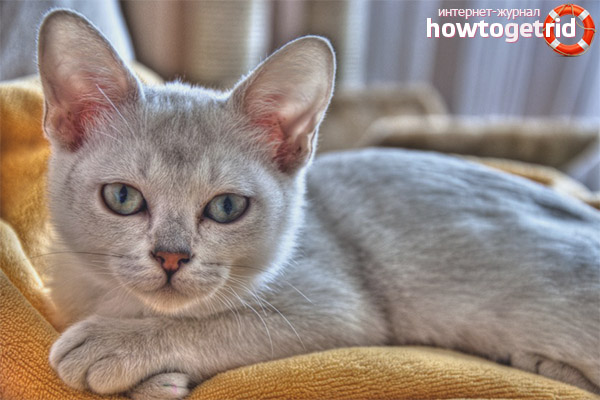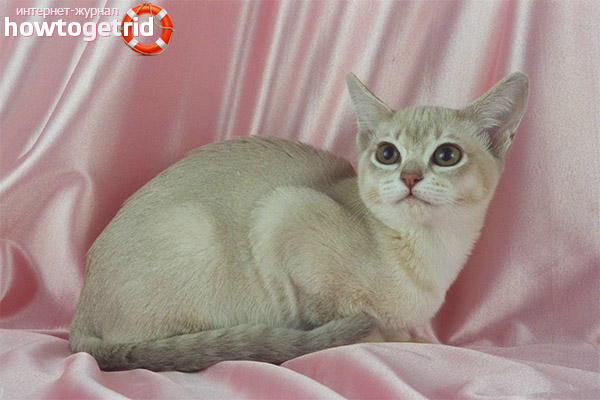The content of the article
Allow me to introduce - Burmilla! This cat is a true English aristocrat. She is so elegant in appearance and intelligent in her manners that many ladies can only envy her. And there is something! After all, some of her habits can only learn.
From the history of the breed
To some, this will seem strange and even unthinkable, but Burmilla is the ancestor of the Persian and Burmese. This breed has another name - Burmese silver. The word burmilla itself is composed of burmese and chinchilla.
Her story began in England in the 81st year of the 20th century, and this happened completely randomly. A baroness citizen of the kingdom named Miranda von Kirchberg kept in her house pedigreed cats, namely Persians and Burmese. She loved them so much that she considered the best gift in the world.For her sincere kindness and special generosity, she presented a Persian chinchilla cat to her friend. He was not going to engage in breeding cats, and the gift was decided to sterilize. The unfortunate animal decided to alleviate its fate by running away from the host, the slaughterer. However, the Persian could not escape far. In the backyard of the ill-fated home, he was met by a charming Burmese cat. Their unexpected encounter led to the appearance of a posterity in the cat. Externally, the kittens looked like a chinchilla Persian. But after a while, they acquired completely different traits. As an adult, it was impossible to say that there were Persian cats in the genus.
Description of breed standards
What can be said about this cat? She is beautiful and sophisticated. It seems that the goddess Aphrodite herself brought these two animals together to produce the fruit of forbidden love. Burmilla just perfectly combines high intelligence, good appearance and morals.
- Torso The sizes and weight are average, closer to large. The average weight of a cat is about 5 kilograms, and a cat - up to 9.
- The body is well coordinated and looks harmonious.Muscular with a strong bone apparatus.
- Tail. Medium or long. Medium in thickness, tapers towards the end.
- Paws. Have a spindle shape. Strong and muscular. Long, rounded at the ends. Rear longer than the front. The paw pads are always black.
- Head. It has an average size. Harmoniously looks in relation to the body.
- The muzzle has pronounced vibrissa pads. The chin should be well developed.
- Eyes. Large sizes. Several distant, with a black rim. This breed can have eyes of the following colors: green, amber, with golden splashes. Kittens - teenagers most often have red color of eyes.
- The outline of the letter "M" on the animal's forehead does not have a clear pattern, but only a hint of it.
- Nose. With a slight bend at the base.
- Wool. Burmill has wool of different lengths. But long-haired are less popular than their not so hairy congeners. They have a coat that is tight to the body, which is distinguished by expressive tipping. It can be red, purple or silver. An undercoat of golden or silver tones is required.The coat on the back is always darker than on the belly.
Color options
Solid: cream, black, dark tortoise, Bombay.
- Smoky: black or chocolate.
- Tabby (tabby): black, blue.
- Shaded: purple, chocolate.
The Burmilla cat looks as if a thin, almost transparent light veil of a darker color is in her body, in a tone like undercoat.
Character traits
Ancestors rewarded their descendants with inexhaustible energy and gentle habits. At a younger age, Burmill kittens are very playful and mobile. Reaching a mature age, the cats of this breed become calmer and more restrained, but by no means boring. They are as inquisitive as they were babies. Burmilla love companies and communication with the human race.
Due to their curiosity, they are often involved in unusual incidents. To their master, they are anxious, and can even protect him in case of danger.
Burmilla with great patience will survive such unpleasant procedures as cleaning the ears and teeth, and even clipping claws can not force a tailed friend to apply aggression towards the owner.
Health
Burmilla has good health, especially with proper care and maintenance. However, from the Persian cats, they inherited a penchant for polycystic kidney disease. This disease is dangerous because it can cause kidney failure. You should be attentive to the health of your pet and feed him correctly in order to avoid similar problems in the future.
If you suspect that the cat has health problems, it must be shown to the veterinarian in order to take timely measures. Pay attention to the following symptoms that signal kidney problems:
- Drowsiness.
- Reducing the amount of food consumed or a complete lack of appetite.
- Increased urination.
- Weight loss.
Features care and maintenance
As a rule, burmilla not picky in the care. Caring for them is no different from what is necessary for cats of other breeds. It includes feeding, health monitoring and timely vaccination, hygiene procedures: combing, bathing, brushing your teeth and ears.
If you are going to become the owner of the cat, you need to take care that she has a place in the house. You can determine it by arranging a pet house there. If the owner does not have clear preferences about the place that he can allocate for the animal, the cat itself can choose it.
To protect your favorite sofa from the encroachments of a tailed friend, you need to immediately acquire a claw post. Otherwise, the pet may choose a sofa with expensive upholstery for sharpening its own claws. Kogtetochku can be bought at the pet store or do it yourself. It does not matter. The main thing is to be in the house from the first day of the appearance of a cat in it.
It is necessary to get at least two special bowls for eating and drinking cats. Most suitable from food-grade plastic with sides up to 5 cm maximum. Convenient when the catware has non-slip legs made of rubber or silicone. Then she will not slide on the floor during the meal.
It is necessary to determine the place where the animal will eat and not give food in other places, throwing it on the floor under your feet. Otherwise, the house risks turning into a dirty and foul-smelling place.A cat, accustomed to being thrown under her feet, will carry her around the house. But a raised cat always runs a bowl when it wants to eat.
The toilet of the animal must be prepared from the moment of moving to a permanent place of residence. It is best to purchase a special tray in the pet store. Usually the kittens go immediately to the tray, if it is with the same filler as in the place where he lived with his mother-cat. This point needs to be clarified with the breeder. The best place for arranging a toilet for a pet is a bathroom or a master toilet.
As for feeding, cat sellers are also most often interested. People for a long time containing cats breed Burmilla, know exactly about the peculiarities of the diet and the taste preferences of animals.
Where can I buy a cat breed Burmilla?
As a rule, the kitten, when selling, already has all the necessary vaccinations, is treated against fleas and parasites, is fully socialized and brought up.
A cat of this breed is very popular in Europe, but several nurseries, as a rule, can be found in their own country.
The price of a burmill is an average of $ 500. Pet class pet will cost less. But cats with valuable pedigree characteristics are much more expensive.
Video: cat breed Burmilla













To send